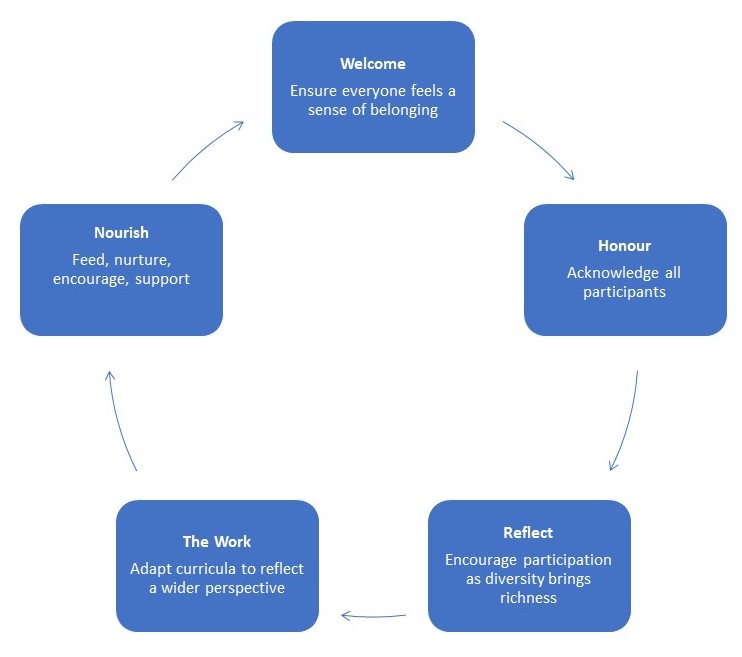
Guest Blogger: Laurie Izgerean, Instructor, BCIT Communication, School of Computing & Academic Studies
“If the legend falls silent, who will teach the children of our ways?” Dan George
It was standing room only when over 65 BCIT employees attended Diversity Circles’ Potlatch Methodology Lunch & Learn on April 24, 2019. A Sḵwx̱wú7mesh (Squamish) welcome song sung by Aaron “Splash” Nelson-Moody and a formal introduction in Híɫzaqv (Heiltsuk) by Dr. Justin Wilson opened the event. Zaa Joseph, co-founder of Diversity Circles and Parker Johnson, long-time friend of the distinguished guests, concluded the welcome and acknowledgement of all participants.
The hour-long conversation included highlights from an article co-written by the hosts:
Looking Back to the Potlatch as a Guide to Truth, Reconciliation, and Transformative Learning “An evolving transformative praxis referred to as “a potlatch methodology” to establish wholistic truth and reconciliation engagement for diverse classroom compositions, drawing on traditional ways of knowing in the authors’ Híɫzaqv (Heiltsuk) and Skwxwú7mesh (Squamish) communities.”
Splash kicked off the conversation by addressing a few of the most common inquires received by fellow educators, and he expanded upon some of the calls to action identified from within the Truth and Reconciliation Commission:
- How are the institution-wide acknowledgements of traditional territories being delivered; what does it mean to the instructor; and how is it heard by Indigenous people? What should we do with respect to indigenizing classrooms and curriculum?
- Thoughtful responses to these complicated questions included a glimpse into the collateral damage caused by colonization which rendered Indigenous people invisible for hundreds of years. When there is an acknowledgement of the traditional territories during a public event, it demonstrates that the past, present, and future Indigenous peoples from those lands are no longer invisible.
We learned this public acknowledgement is similar to traditional Nation to Nation “hold up your paddle” communications when travelling to and from a neighbouring territory by canoe. Indigenous protocol compels a visitor to identify where they’re from and to communicate their intentions while passing through or visiting. Once visitors are informed of those local protocols, it’s understood they will abide by them out of respect for the host Nation(s).
The Potlatch Methodology
The Potlatch, which strives to recognize one’s humanity within their own house, has been in existence for 15,000 years. As a guiding methodology towards transformative learning, it’s reflective of First Nations and Indigenous communities. Potlatch attributes include a ritualized process to publicly conduct work towards lasting change. In practice, diverse participants share intercultural knowledge and gifts to maximize a collective transformation. However, as the bulk of modern education exists within the context of colonialism, indigenizing curriculum will be an ongoing process rather than a quick fix. By taking a cyclical approach to the indigenization of each lesson, educators can make ongoing refinements and re-evaluations along the way to ensure classrooms become what Justin describes as “a place to celebrate learning and being human”:
Wayfinding
To get to where we’re going, Justin shares a lesson from his youth where he was given valuable advice from a community elder: “We need to turn around once in awhile to find our way back home.” To decolonize and indigenize curricula, we first need to decolonize ourselves. This reflective process begins with recognizing our privilege, current socio-economic imbalances, and our explicit and implicit biases. When we acknowledge that we are learning, we can better understand domestic and international student experiences “using cultural humility and safety to come out from behind the podium.”
How can we help students find their way and tap into the best of who they are?
- Teach from a position of humility so those who are hurting feel safe to become who they are
- Create a space that celebrates learning and teaches how to be a global citizen
- Explore what it means to be human in a respectful, mindful, and equitable environment
- Learn how to walk together with one heart and one mind
While we continue to educate and administer education to others, Justin and Splash suggest we “acknowledge ourselves as a learner when it comes to understanding another’s experience.” They have also provided us with an extensive book/reading list to expand our understanding of what it’s like to walk a mile in another one’s moccasins, jute, xie, chausse, obuv’, zapatos, gigakizine, or shoes ?
Reading List and Links
- Human Dignity and Humiliation Studies
- Indigenization as inclusion, reconciliation, and decolonization: navigating the different visions for indigenizing the Canadian Academy(Adam Gaudry, Danielle Lorenz)
- Less Than Human: Why we demean, enslave, and exterminate others (David Livingstone Smith)
- Looking Back to the Potlatch as a Guide to Truth, Reconciliation, and Transformative Learning (Justin Wilson and Aaron Nelson-Moody)
- Post Traumatic Slave Syndrome (Dr. Joy Degruy)
- Reconciling and Rehumanizing Indigenous–Settler Relations: An Applied Anthropological Perspective (Nadia Ferrara)
- Unsettling the Settler Within (Paulette Regan)
- White Fragility (Robin Diangelo)
